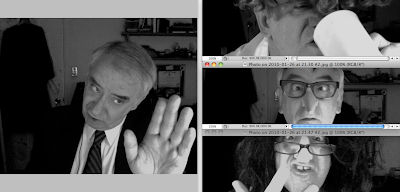
The other day Steve Worth showed me his new $200 book on the circus. Well, actually it cost $126 on Amazon, but it was big and heavy, and I found myself wondering if the publisher could really make a profit on it, even at full price.
With that in mind, I thought I'd reminisce a little about my own two trips to the circus with my dad when I was a kid. Both were really big shows: one was in a convention center, and the other was in huge circus tents, just like the ones in "Dumbo."

The one in tents was my favorite. They were surrounded on three sides by a fence (above). To find the entrance you just followed the crowd.

There were was a side show (above), and it was so interesting that I didn't want to leave it, but once inside the canvas I completely forgot about it. The thrill of the interior volumes took my breath away and the smells and the hurly burly of the crowd were unforgettable.
There were audience "warmers" just like today, and a terrific band to whip the crowd into a frenzy. Just when the crowd was ready to burst a parade commenced and the ringmaster came out.

Every guy in the audience must have envied the ringmaster. He was completely masculine, intelligent, confident, impeccably dressed, and had a booming voice. He introduced all the acts, beginning with a horse show (above). after that came clowns splashing around in a pool.

Then came the aerialists (above) and tight rope walkers. You ended up falling in love with the women in the act, who had the knack of catching every man's eye and giving him the impression that he and he alone had been singled out for their special affection.

Then the sound of roaring lions heralded the lion tamer, and when he was done seals came out on a ramp and flopped into the clown pool.

The seals were great! They actually seemed to enjoy performing, then they left and human divers took their place. I can only guess at the condition of the water.

Then came a solemn time as the lights lowered and the men billed as the strongest in the world came on. Before they performed they strutted around the front of the crowd flexing their muscles for the ladies.

Then came the pugilists...well, not really. There were no pugilists when I was there, but this poster I found (above) makes a strong case that there should have been. Did they really fight all together as in the picture above? I wouldn't be surprised if they did, at least in the grand finale!

Next came the grand finale where everybody came out and performed all at once, then peeled off, one by one, to participate in a grand parade. Guys with stilts played instruments, girls on horseback shot balloons, clowns went bananas, and elephants did fancy walks, all at the same time.

The band went into overdrive, and at the creschendo of the music multiple canons went off, and all assembled gracefully bowed to the audience as a rain of baloons fell from the tent tops. The crowd went nuts and applauded almost til the skin came off their hands.
That was quite a show. Quite a show.










































